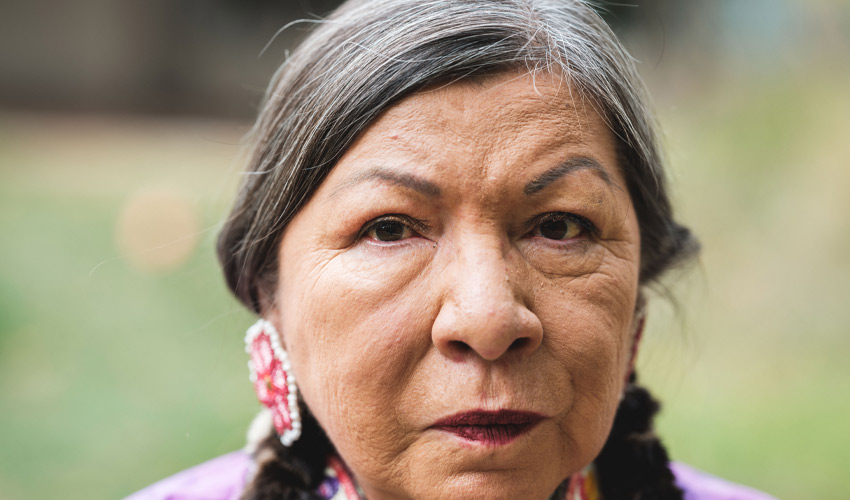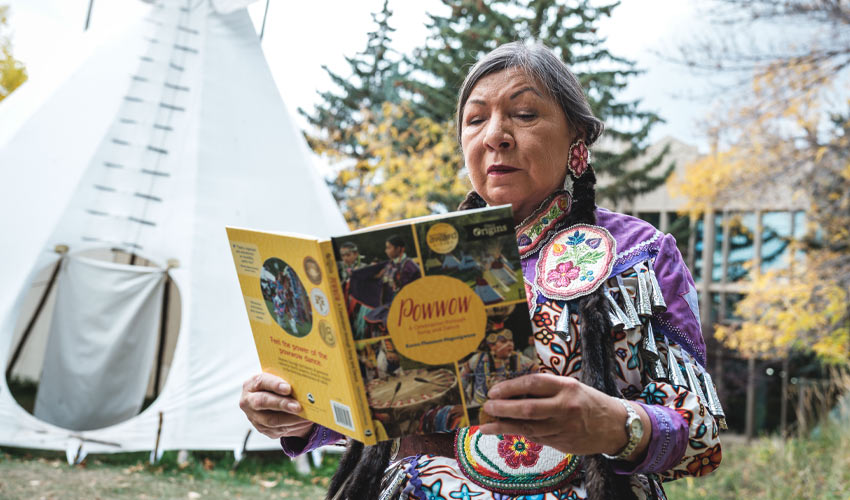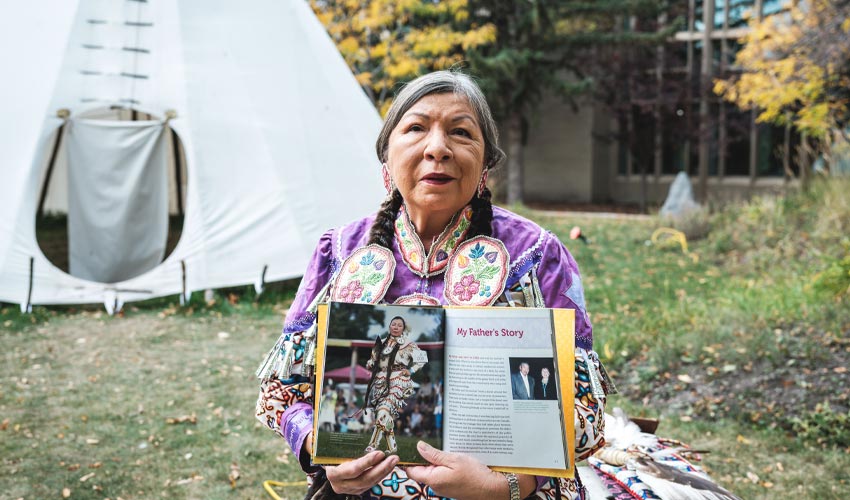Assistant Professor Karen Pheasant-Neganigwane to be inducted into the Canadian Dance Hall of Fame
— Mount Royal University | Posted: October 25, 2023

Mount Royal University Assistant Professor Karen Pheasant-Neganigwane.
Assistant Professor Karen Pheasant-Neganigwane is soon to be inducted into the Canadian Dance Hall of Fame by Dance Collection Danse (DCD) at the Encore! Dance Hall of Fame Induction Ceremony in early November. An Anishinaabe Jingle Dress dancer from Wiikwemkoong on Manitoulin Island, Ont., who teaches in the Department of General Education and the Department of Humanities (Indigenous studies) at MRU.
“Karen quite literally wrote the book on powwow,” says Amy Bowring executive and curatorial director for DCD. “Her work to ensure that current and future generations understand the history of powwow dances and the key elements of each dance is and will continue to be so important in our awareness of the dances of Indigenous Peoples.”
Pheasant-Neganigwane’s award-winning book, Powwow: A Celebration through Song and Dance, won the Norma Fleck Award for Best Canadian Children’s Non-Fiction Book in 2021. The book explores the history and the cultural significance of powwow, with a goal being for it to be used in classrooms where students can explore colonization and its damaging effects to Indigenous people. The book breaks down the complicated history of Canadian policy on Indigenous Peoples and allows all ages to obtain a clearer understanding.
Pheasant-Neganigwane was an ideal choice for this award given her willingness to take risks and to contribute to reasserting Indigenous dance and culture in Canada.
Bowring explains this further. “Long before the word ‘reconciliation’ was on the lips of Canadians, Karen was doing the work to recover, promote and celebrate the dances of Indigenous Peoples. And the writing, teaching and dancing that Karen has dedicated her life to is a legacy to be proud of. The actions of the Canadian state have robbed generations of First Nations, Métis, Inuit and settlers of the chance to know and celebrate the cultures of so many nations of people across this land — Karen's work is one more step in reversing that loss.“
Contemporary and "straight" or traditional forms of the jingle dance
The Jingle Dress dance represents healing, pride, wellness and celebration. Dresses are lined with rows and rows of metal cones, which jingle along with drumming, adding another dimension to the music. Women and girls also often dance with feather fans, eagle feather plumes or eagle feathers in their hair. The Jingle Dress dance has been modified by different nations as it was adopted across North America from its origins among the Ojibwe.
Pheasant-Neganigwane recalls a story of when she taught Indigenous dance at the Banff Centre in 2003. She was working on a theatre piece “that talks about the conundrum that exists between the original style of this dance” and the personal renditions that other dancers bring forward on the powwow floor. Pheasant-Neganigwane is, as she puts it, a “straight” dancer of the Jingle Dress dance, however the artistic director, who Pheasant-Neganigwane respected and admired, Muriel Miguel, encouraged her to push her limits and to try and showcase the freestyle versions that existed, such as spins, twirls, high stepping and complicated footwork.

Karen Pheasant-Neganigwane’s award-winning book, Powwow: A Celebration through Song and Dance, won the Norma Fleck Award for Best Canadian Children’s Non-Fiction Book in 2021.
Pheasant-Neganigwane emphasizes that she still holds true to the traditional style that she witnessed at the Lake of the Woods area in Ontario and Minnesota (the original home of the Jingle Dress). However, she recognizes and sees the validity of the uniqueness and beauty in more creative and freestyle versions of the dance.
“It’s obvious there’s a lot of energy and work that goes into what these young women are doing.”
But the distinction between traditional and freestyle is important in order to preserve the ethics and integrity of the Jingle Dress dance.
The ABC's of Indigenous People
Pheasant-Neganigwane’s openness and appreciation for more creative styles of the Jingle Dress dance is due to the blessings she’s always seen in the cultures of Indigenous Peoples. She calls it the “ABC’s” of who Indigenous people are: amazing, brilliant, and courageous.
Also a university educator with the Faculty of Education at the University of Alberta, Pheasant-Neganigwane has unfortunately seen that Canadians sometimes recognize the opposite. She speaks of instances where she’s lectured at the University of Alberta and at MRU, and asked students to reflect on why issues exist in Indigenous communities.
“In some of the lectures, there was still a consensus, anonymously, where they would say, ‘Because we’re drunk, stupid, lazy Indians.’ That perception still exists. Yes, we have our issues, but look at the past system, the federal legislation that created that, and so the work we do is vital and important.”
Indigenous trauma is Canadian trauma
When the news broke about the 215 unmarked graves of Indigenous children in Kamloops, Pheasant-Neganigwane relayed a story in which her son had gone to get items for his child at a store. The cashier broke down into tears as someone deeply affected by the news like many Canadians were. Pheasant-Neganigwane also tells of times in which she would give presentations to non-Indigenous audiences, and there would be participants crying.
These types of experiences are all too familiar. “The healing that needs to happen is not only for Indigenous people, but by Canadian society, as they believed all the lies that the school curriculum taught them,” Pheasant-Neganigwane says.

Pheasant-Neganigwane's book breaks down the complicated history of Canadian policy on Indigenous Peoples and allows all ages to obtain a clearer understanding.
Integrating dance into her teaching, Pheasant-Neganigwane has been known to play a little bit of Marvin Gaye in some of her general education courses. She explains that using movement in teaching is an example of not only of Indigenous ways of knowing, but of Indigenous Being.
“Growing up, I was often made to think that dance was a frill and of no consequence by schoolmates or parents of friends. But I've never bought into that idea,” Bowring says.
“If dance was of no great consequence, then the Canadian state would not have banned Indigenous Peoples from performing their dances beginning in 1884. The English wouldn't have banned Scottish Highlanders from dancing after the Jacobite Rebellion in the 1740s. And certain Islamic states wouldn't be banning it now. Clearly, dance is a significant part of our humanity — we have been moving to rhythm as a species for so long that recorded history can't even cite the first instance of humans dancing.”

